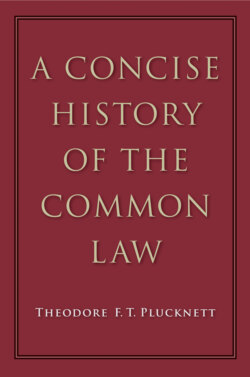Читать книгу A Concise History of the Common Law - Theodore F. T. Plucknett - Страница 44
На сайте Литреса книга снята с продажи.
CHAPTER 6 THE TUDORS: RENAISSANCE, REFORMATION AND RECEPTION SUMMARY
ОглавлениеThe Mediaeval Achievement
The Renaissance and the State
The Reformation
The Reformation and the Law
The Reformation and the Constitution
The Reception
Tudor Legislation
The Close of the Tudor Age
The house of Tudor came to the throne with the accession of Henry VII after the battle of Bosworth in 1485, and ruled England during one of its most brilliant periods, the sixteenth century, until the death of Queen Elizabeth in 1603. It was the golden age of literature, beginning with Sir Thomas More and ending with Bacon and Shakespeare; an age, too, of heroic adventure when the seamen ranged the ocean in search of new continents, and planted distant colonies whose future they could never have guessed. But besides the remote new worlds which adventurers had discovered, there was something like a new world in old Europe too. A wave of new ideas was remaking the intellectual life of Italy and France, Germany and England, and these ideas are usually grouped together by historians under the three headings of the Renaissance, the Reformation and the Reception. The movement begins with the revival of classical studies, and especially of Greek. Sometimes this resulted in a sort of new paganism; instead of the frigid logic of Aristotle which had dominated the middle ages, attention turned to the genial romance of Plato, and to the poets. More occasionally the movement took a distinctly religious form, and the tragic lives of Pico, Politian and Savonarola illustrate the beauty of Christianity lived in the light of classical humanism. In England the movement is represented best by Sir Thomas More, Chancellor, historian and romantic philosopher, who combined a platonic fancy for Utopias with a steadfast devotion to traditional Catholicism which cost him his life in 1534. Erasmus also was influential in England, where he lived for some time as Professor of Greek at Cambridge. As with every great intellectual movement, the Renaissance had profound effects upon the conception of law.
